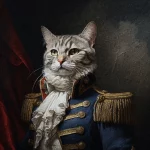In the world of animal shelters and rescue organizations, the daily task of providing care, finding homes, and ensuring the well-being of animals is both challenging and rewarding. However, the financial strain of maintaining these essential services often requires creative and effective fundraising strategies.
One innovative approach gaining traction is the use of pet portraits as a means of generating support.
Pet portraits, capturing the unique essence and personality of beloved animals, have an innate ability to resonate deeply with pet owners. These portraits transform the emotional bond between people and their pets into a powerful fundraising tool.
By offering personalized artwork that immortalizes cherished companions, shelters and rescues can appeal to the heartstrings of potential donors while simultaneously raising much-needed funds.
This fundraising method not only provides a direct source of revenue but also strengthens community engagement and increases awareness of the shelter’s mission.
As pet owners seek to celebrate and honor their animals through art, they simultaneously contribute to the well-being of other animals in need. The intersection of art and philanthropy creates a compelling narrative that can drive significant support for these vital organizations.
The Appeal of Pet Portraits
Pet portraits hold a special place in many people’s hearts because they capture the unique personality and charm of beloved pets. For pet owners, pets are often considered family members, and the desire to preserve their likeness in art stems from a profound emotional attachment.
The appeal of pet portraits lies in their ability to immortalize these cherished companions, making them more than just images but personal treasures.
A well-executed pet portrait not only showcases a pet’s physical features but also conveys their character and spirit. Artists skilled in pet portraiture can capture the nuanced expressions and idiosyncrasies that make each pet unique, resulting in artwork that resonates deeply with pet owners.
This emotional value enhances the effectiveness of pet portrait fundraisers by tapping into the strong bonds between people and their pets.
Pet portraits can be created in various styles, from realistic to abstract, offering a range of options to suit different tastes. This diversity allows pet owners to choose a portrait style that reflects their personal preferences and the personality of their pet.
The versatility in artistic styles ensures that the portraits can appeal to a broad audience, increasing the potential for successful fundraising.
Additionally, pet portraits serve as lasting mementos. Unlike other forms of donations or merchandise, a pet portrait is a personalized item that holds sentimental value.
This intrinsic worth can motivate pet owners to participate in fundraising efforts, as they see the portrait as a meaningful way to support a cause they care about while celebrating their own pets.
The Mechanics of Fundraising with Pet Portraits
- Choosing the Right Artist: The success of a pet portrait fundraising campaign hinges on the quality of the artwork produced. Collaborating with experienced artists who specialize in pet portraiture is crucial.
These artists should have a proven track record of creating lifelike and emotionally resonant portraits. Their portfolios should reflect their ability to capture the essence of a pet, as this will directly impact the appeal of the portraits.
When selecting an artist, shelters and rescues should consider factors such as the artist’s style, reputation, and availability. It’s beneficial to work with artists who are enthusiastic about supporting animal welfare causes, as this can lead to a more genuine and committed collaboration.
Additionally, establishing clear agreements regarding the scope of work, deadlines, and compensation is essential to ensure a smooth partnership. - Setting Up the Fundraising Campaign: There are various approaches to integrating pet portraits into fundraising campaigns. Each method has its own advantages and can be tailored to suit the specific goals and audience of the shelter or rescue.
- Silent Auctions: Silent auctions can be a highly effective way to raise funds through pet portraits. This method involves displaying the portraits at an event, such as a gala or charity auction, where attendees can place bids.
Silent auctions create a competitive environment that can drive up the final bid amounts, resulting in higher fundraising totals. To maximize success, it’s important to promote the event widely and ensure that the portraits are showcased in a visually appealing manner. - Direct Sales: Selling pet portraits directly to the public is another viable option. This can be done through an online platform, a physical store, or at fundraising events.
Direct sales allow for immediate revenue generation and can be particularly effective if the portraits are promoted through social media, email newsletters, and local advertising.
This method also provides an opportunity for ongoing sales, as pet owners who missed the initial campaign can still purchase portraits at a later date. - Donation-Based Portrait Offers: Offering pet portraits in exchange for donations provides a personal touch to the fundraising effort. For example, donors who contribute a certain amount to the shelter or rescue could receive a custom pet portrait as a thank-you gift.
This approach not only incentivizes higher donations but also creates a tangible reward for supporters. It’s important to clearly communicate the donation thresholds and ensure that the portraits are delivered in a timely manner.
- Marketing and Promotion: Effective marketing is essential for the success of a pet portrait fundraising campaign. Shelters and rescues should develop a comprehensive marketing strategy that includes social media, email campaigns, and local media outreach.
- Social Media: Platforms like Facebook, Instagram, and Twitter are powerful tools for promoting pet portrait fundraisers. Shelters and rescues can share images of the portraits, highlight stories of the animals benefiting from the fundraiser, and engage with potential donors through interactive content. Social media ads can also target specific audiences, increasing the reach of the campaign.
- Email Newsletters: Sending targeted email newsletters to supporters can keep them informed about the fundraiser and encourage participation. Including stories, testimonials, and updates about the campaign can help maintain interest and drive engagement.
- Local Media: Engaging with local newspapers, radio stations, and TV channels can increase visibility and attract new supporters. Press releases and media appearances can help generate buzz and reach a wider audience.
- Collaboration and Partnerships: Partnering with local businesses and organizations can enhance the effectiveness of the fundraising campaign. Collaborations with pet stores, veterinary clinics, and other businesses can provide additional exposure and resources.
- Pet Stores and Veterinary Clinics: These businesses often have a direct connection to pet owners and can help promote the fundraiser through their own networks. They may also be willing to donate items for auctions or offer their own services as part of the campaign.
- Local Artists and Art Galleries: Partnering with local artists and art galleries can provide additional support and credibility to the fundraiser. Art galleries, in particular, can host exhibitions or events showcasing the pet portraits, attracting art enthusiasts and potential donors.
Benefits of Using Pet Portraits for Fundraising
- Emotional Connection: Pet portraits leverage the emotional bonds that people have with their pets, making them a powerful fundraising tool. The emotional value of a portrait can encourage pet owners to contribute more generously, as they see the fundraiser as a way to honor their pets while supporting a worthy cause. This emotional connection can also lead to higher engagement and a greater sense of personal investment in the fundraiser.
- Increased Visibility: Pet portrait fundraisers often attract attention from both local and online communities. The visual appeal of the portraits, combined with compelling stories about the animals they support, can create a strong narrative that resonates with potential donors. Increased visibility can lead to greater awareness of the shelter or rescue’s mission, potentially attracting new supporters and fostering long-term relationships.
- Community Engagement: Engaging the community through pet portrait fundraisers can build a sense of shared purpose and involvement. Pet owners who participate in the campaign become advocates for the shelter or rescue, helping to spread the word and encourage others to contribute. This community engagement can also lead to increased volunteer support and a stronger network of supporters.
- Ongoing Support: The relationships built through pet portrait fundraisers can lead to ongoing support for the shelter or rescue. Donors who have participated in the campaign may continue to contribute in other ways, such as through volunteering, fostering animals, or adopting pets. The positive experience of participating in the fundraiser can create lasting goodwill and a deeper commitment to the organization’s mission.
Challenges and Considerations
- Artist Availability: Securing the participation of talented artists can be challenging, particularly if they are in high demand. Shelters and rescues need to plan well in advance and establish clear agreements with artists to ensure their involvement. It’s important to build strong relationships with artists and offer incentives, such as recognition and exposure, to encourage their participation.
- Marketing Efforts: Successfully promoting a pet portrait fundraiser requires significant time and effort. Shelters and rescues must invest in developing and implementing effective marketing strategies to reach potential donors. This includes creating engaging content, leveraging social media platforms, and utilizing local media. Effective marketing is essential for driving participation and ensuring the success of the campaign.
- Quality Control: Ensuring the quality of the portraits is crucial for maintaining donor satisfaction. It’s important to work closely with artists to set clear expectations regarding the final product and to address any issues that may arise. High-quality portraits will not only satisfy donors but also enhance the overall reputation of the fundraiser.
- Logistics and Execution: Organizing a pet portrait fundraiser involves logistical considerations, such as coordinating events, managing donations, and handling the delivery of portraits. Careful planning and organization are essential to address these challenges and ensure a smooth execution of the campaign. This includes managing timelines, tracking donations, and ensuring that portraits are delivered promptly to donors.
Conclusion
Utilizing pet portraits as a fundraising strategy for animal shelters and rescues offers a compelling fusion of art and philanthropy that taps into the deep emotional bonds people share with their pets
By capturing the unique personalities and endearing qualities of beloved animals, pet portraits transform into cherished keepsakes that resonate with pet owners on a personal level.
This emotional connection is leveraged effectively in fundraising efforts, encouraging greater engagement and higher contributions from the community.
The benefits of incorporating pet portraits into fundraising campaigns are multifaceted. They not only create a strong emotional appeal that drives donations but also increase the visibility of shelters and rescues, fostering a broader base of support.
Through successful marketing, strategic partnerships, and quality collaborations with skilled artists, pet portrait fundraisers can elevate the profile of animal welfare organizations and their missions.
Moreover, pet portrait fundraisers enhance community engagement by involving pet owners in a meaningful way. This involvement builds lasting relationships and encourages ongoing support, extending beyond the initial campaign.
As pet owners participate, they become advocates for the cause, helping to spread awareness and garner additional support through their networks.
However, like any fundraising effort, organizing a pet portrait campaign requires thoughtful planning and execution. Challenges such as artist availability, effective marketing, and logistical considerations must be addressed to ensure the campaign’s success.
By approaching these challenges with a strategic mindset and leveraging the passion for pets that exists within the community, shelters and rescues can create impactful fundraisers that contribute significantly to their operational needs.
In summary, pet portraits offer a unique and heartfelt approach to fundraising that aligns perfectly with the mission of animal shelters and rescues.
They provide a way to celebrate the special bond between people and their pets while generating essential funds to support the care and welfare of animals in need.
By embracing the power of art and the deep emotional connections people have with their pets, shelters and rescues can foster a supportive community, achieve their financial goals, and continue their vital work in improving the lives of animals.














